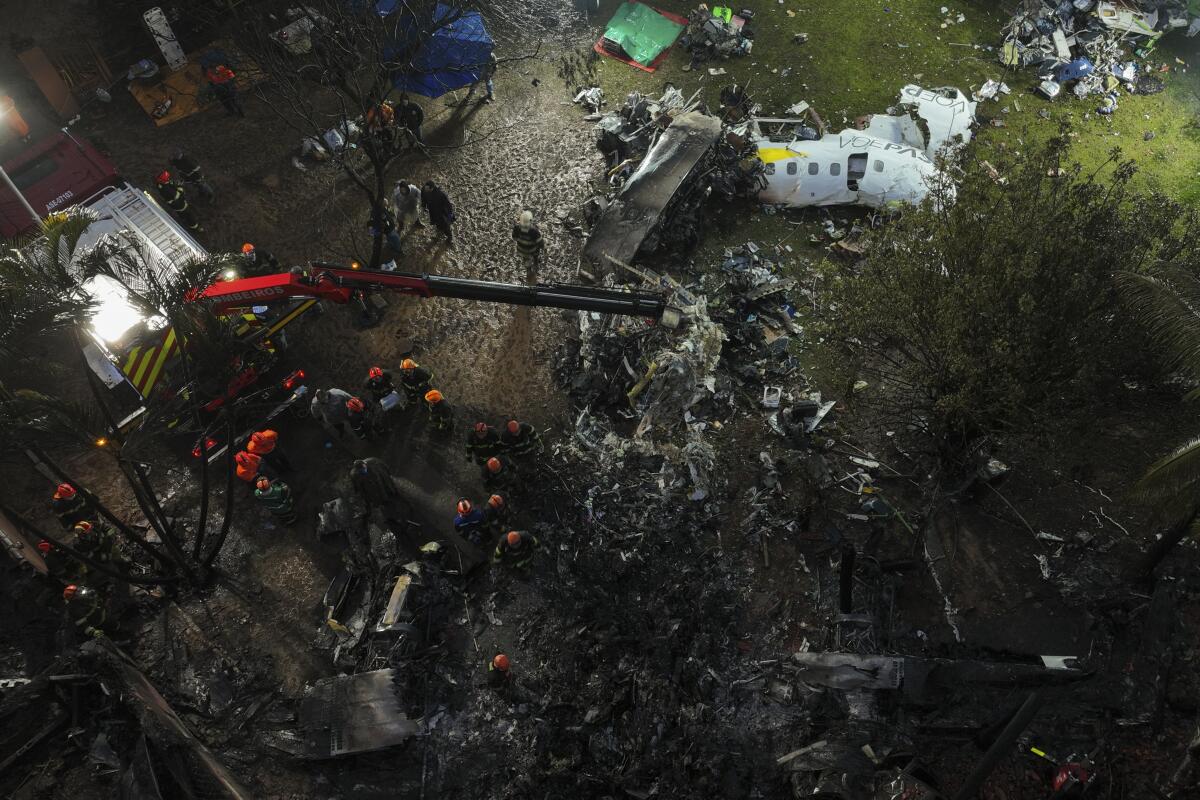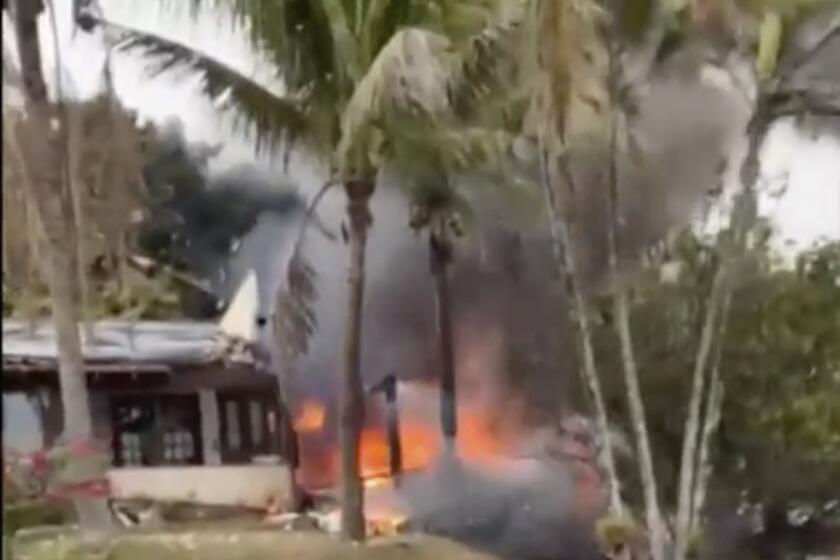Rescuers retrieve remains of all 62 passengers in Brazil plane crash. Families gather in Sao Paulo

- Share via
VINHEDO, Brazil — Brazilian rescue teams have retrieved the remains of all 62 passengers from the wreckage of a plane crash in Sao Paulo state as families started gathering in the metropolis to identify and bury their loved ones.
Local airline Voepass’ plane, an ATR 72 twin-engine turboprop, was headed for Sao Paulo’s international airport in Guarulhos on Friday with 58 passengers and four crew members, when it went down in the city of Vinhedo.
Initially, the company said its plane had 62 passengers, then it revised the number to 61, and early on Saturday it raised the figure once again after it found a passenger named Constantino Thé Maia was not on its original list.
Voepass also said three passengers who held Brazilian identification also carried Venezuelan documents and one had Portuguese.
Sao Paulo state government said in a statement Saturday that rescue operations finished at 6:30 p.m. local time, with the identification of the bodies of the pilot and co-pilot by forensics experts. There were 34 male and 28 female bodies in the wreckage, the government said.
Brazilian authorities began transferring the corpses to the morgue Friday, and called on victims’ family members to bring any medical, X-ray and dental exams to help identify the bodies. Blood tests were also done to help identification efforts.
A passenger plane crashes into a residential area in Brazil’s Sao Paulo state, killing all 61 people aboard, airline says.
Images recorded by witnesses showed the aircraft in a flat spin and plunging vertically before smashing to the ground inside a gated community, and leaving an obliterated fuselage consumed by fire. Residents said there were no injuries on the ground.
Rain drizzled down on rescue workers as they recovered the first bodies from the scene in the chill of the Southern Hemisphere’s winter. Some residents of the gated community silently left to spend the night elsewhere. None were spotted returning on Saturday.
It was the world’s deadliest airline crash since January 2023, when 72 people died on board a Yeti Airlines plane in Nepal that stalled and crashed while making its landing approach. That plane also was an ATR 72, and the final report blamed pilot error.
Metsul, one of Brazil’s most renowned meteorological companies, said Friday there were reports of severe icing in Sao Paulo state around the time of the crash. Local media cited experts pointing to icing as a potential cause for the accident.
A video shared on social media channels Saturday shows a Voepass pilot telling passengers of a flight from Guarulhos to the city of Cascavel, the same origin of the crashed plane, that the ATR 72 has flown safely around the world for decades. He also asked passengers to be respectful to the memory of his colleagues and the company and asked for prayers.
“It was a fatality. The pilot was my personal friend. I have known all the crew from long ago,” the unidentified pilot said. “We are professionals, we have our families. This tragedy doesn’t hit only those who perished in this accident. It hits all of us.”
Local police restricted access to the main entrance of one of Sao Paulo’s morgues, where bodies from the crash were being identified. Many family members were gathering at a hotel in downtown Sao Paulo.
An American Eagle ATR 72-200 crashed on Oct. 31, 1994, and the United States National Transportation Safety Board determined that the probable cause was ice buildup while the plane was circling in a holding pattern. The plane rolled at about 8,000 feet and dived into the ground, killing all 68 people on board. The U.S. Federal Aviation Administration issued operating procedures for ATRs and similar planes, telling pilots not to use the autopilot in icing conditions.
But Brazilian aviation expert Lito Sousa cautioned that meteorological conditions alone might not be enough to explain why on Friday the plane fell in the manner that it did.
“Analyzing an air crash just with images can lead to wrong conclusions about the causes,” Sousa told the AP by phone. “But we can see a plane with loss of support, no horizontal speed. In this flat spin condition, there’s no way to reclaim control of the plane.”
Brazil’s air force said Saturday both black boxes of the plane had been sent to its analysis laboratory in the capital Brasilia. The results of its investigations are expected to be published within 30 days, it said.
Marcelo Moura, director of operations for Voepass, told reporters Friday night that, while there were forecasts for ice, they were within acceptable levels for the aircraft.
Likewise, Lt. Col. Carlos Henrique Baldi of the Brazilian air force’s center for the investigation and prevention of air accidents, told reporters in a late afternoon news conference that it was still too early to confirm whether ice caused the crash.
The plane is “certified in several countries to fly in severe icing conditions, including in countries unlike ours, where the impact of ice is more significant,” said Baldi, who heads the center’s investigation division.
In an earlier statement, the center said the plane’s pilots did not call for help or say they were operating under adverse weather conditions. Brazil’s Federal Police said it began its own investigation.
French-Italian plane manufacturer ATR said in a statement it was “fully engaged” to support the investigation. The ATR 72, generally used on shorter flights, is built by a joint venture of Airbus in France and Italy’s Leonardo S.p.A.
Associated Press writers Savarese reported from Vinheo, Sá Pessoa from Sao Paulo and Koenig from Dallas. AP videojournalist Tatiana Pollastri contributed to this report.
More to Read
Sign up for Essential California
The most important California stories and recommendations in your inbox every morning.
You may occasionally receive promotional content from the Los Angeles Times.










